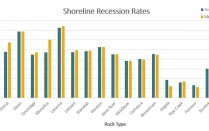Lake Erie Shoreline Bluff Erosion
By: Emily DeMieri, Baylor University
Advisor: James Boyle, PhD, Department of Earth Science, University at Buffalo
Advisor: Jason Briner, PhD, Department of Earth Science, University at Buffalo
Project Objectives
•Shoreline erosion poses risks to humans and infrastructure
•Aim to assess shoreline bluff erosion over time
•Finding a correlation between shoreline recession rate and bedrock lithology
Data and Results
•Digitizing US Topographic map shorelines from the last century in ArcGIS Pro to find a rate of change
•Evaporites have eroded faster than shales
•Conducted a small-scale study at Sturgeon Point in Marina in Evans, NY to observe a shoreline with shale and glacial till.
•The blocky shale cliffs have more evidence of erosion than the sloping glacial till
Significance
•Fast erosion rates means properties will be negatively affected by shoreline collapse sooner
•Northern Lake Erie, where evaporites are present may experience higher risk of the negative effects of shoreline erosion
•Future more precise work is necessary to rule out methodolgical biases
Publication or Conference
E. DeMieri, J. Boyle, J. Briner, 2025. Effects of Western New York Varying Bedrock on Lake Erie Shoreline Bluff Erosion, American Geophysical Union 2025 Conference, Online Poster.
------------------------------------------------------------------------------------------------
Center for Geological and Climate Hazards
Interdisciplinary Research Experience for Undergraduates in Atmospheric and Geological Hazards

Shoreline Recession from 1894 to 2023, categorized by bedrock formation. The Salina Group is composed of evaporites, Akron of Dolostone, Onondaga is limestone, and all remaining members are shale.